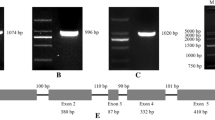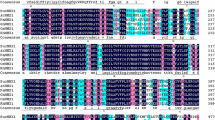Abstract
One of the protective mechanisms used by plants to survive under conditions of salt stress caused by high NaCl concentration is the removal of Na+ from the cytoplasm. This mechanism involves a number of Na+/H+-antiporter proteins that are localized in plant plasma and vacuolar membranes. Due to the driving force of the electrochemical H+ gradient created by membrane H+-pumps (H+-ATPases and vacuolar H+-pyrophosphatases), Na+/H+-antiporters extrude sodium ions from the cytoplasm in exchange for protons. In this study, we have identified the gene for the barley vacuolar Na+/H+-antiporter HvNHX2 using the RACE (rapid amplification of cDNA ends)-PCR (polymerase chain reaction) technique. It is shown that the identified gene is expressed in roots, stems, and leaves of barley seedlings and that it presumably encodes a 59.6 kD protein composed of 546 amino acid residues. Antibodies against the C-terminal fragment of HvNHX2 were generated. It is shown that the quantity of HvNHX2 in tonoplast vesicles isolated from roots of barley seedlings remains the same, whereas the rate of Na+/H+ exchange across these membranes increases in response to salt stress. The 14-3-3-binding motif Lys-Lys-Glu-Ser-His-Pro (371–376) was detected in the HvNHX2 amino acid sequence, which is suggestive of possible involvement of the 14-3-3 proteins in the regulation of HvNHX2 function.
Similar content being viewed by others

REFERENCES
Bohnert, H. J., Nelson, D. E., and Jensen, R. G. (1995) Plant Cell, 7, 1099–1111.
Blumwald, E., Aharon, G. S., and Apse, M. P. (2000) Biochim. Biophys. Acta, 1465, 140–151.
Epstein, E. (1998) Science, 280, 1906–1907.
Bressan, R. A., Hasegava, P. M., and Pardo, J. M. (1998) Trends Plant Sci., 3, 411–412.
Hasegawa, P. M., Bressan, R. A., Zhu, J. K., and Bohnert, H. J. (2000) Annu. Rev. Plant Mol. Plant Physiol., 51, 463–499.
Liu, J., and Zhu, J. K. (1998) Science, 280, 1943–1945.
Liu, J., Ishitani, M., Halfter, U., Kim, C. S., and Zhu, J. K. (2000) Proc. Natl. Acad. Sci. USA, 97, 3730–3734.
Shi, H., Ishitani, M., Wu, S.-J., Kim, C.-S., and Zhu, J. K. (2000) Proc. Natl. Acad. Sci. USA, 97, 6896–6901.
Gaxiola, R. A., Li, J., Undurraga, S., Dang, L. M., Allen, G. J., Alper, S. L., and Fink, G. R. (2001) Proc. Natl. Acad. Sci. USA, 98, 11444–11449.
Apse, M. P., Aharon, G. S., Snedden, W. A., and Blumwald, E. (1999) Science, 285, 1256–1258.
Zhang, H. X., and Blumwald, E. (2001) Nat. Biotechnol., 19, 765–768.
Zhang, H. X., Hodson, J. N., Williams, J. P., and Blumwald, E. (2001) Proc. Natl. Acad. Sci. USA, 98, 12832–12836.
Maeshima, M., and Yoshida, S. (1989) J. Biol. Chem., 264, 20068–20073.
Shan’ko, A. V., and Babakov, A. B. (2002) Fiziol. Rast., 49, 847–853.
Palmgren, M. G. (1991) Analyt. Biochem., 192, 316–321.
Clerc, S., and Barenholz, Y. (1998) Analyt. Biochem., 259, 104–111.
Counillon, L., Franchi, A., and Pouyssegur, J. (1993) Proc. Natl. Acad. Sci. USA, 90, 4508–4512.
Sehnke, P. C., Rosenquist, M., Alsterfjord, M., DeLille, J., Sommarin, M., Larsson, C., and Ferl, R. J. (2002) Plant. Mol. Biol., 50, 1011–1018.
Li, X., Liu, Y., Kay, C. M., Muller-Esterl, W., and Fliegel, L. (2003) Biochemistry, 42, 7448–7456.
Counillion, L., and Pouysseger, J. (2000) J. Biol. Chem., 275, 1–4.
Yokoi, S., Quintero, F. J., Cubero, B., Ruiz, M. T., Bressan, R. A., Hasegawa, P. M., and Pardo, J. M. (2002) Plant J., 30, 529–539.
Venema, K., Quintero, F. J., Pardo, J. M., and Donaire, J. P. (2002) J. Biol. Chem., 277, 2413–2418.
Venema, K., Belver, A., Marin-Manzano, M. C., Rodriguez-Rosales, M. P., and Donaire, J. P. (2003) J. Biol. Chem., 278, 22453–22459.
Orlowski, J., and Grinstein, S. (1997) J. Biol. Chem., 272, 22373–22376.
Nass, R., and Rao, R. (1998) J. Biol. Chem., 273, 21054–21060.
Bowers, K., Levi, B. P., Patel, F. I., and Stevens, T. H. (2000) Biochim. Biophys. Acta, 1465, 140–151.
Hamada, A., Shono, M., Xia, T., Ohta, M., Hayashi, Y., Tanaka, A., and Hayakawa, T. (2001) Plant Mol. Biol., 46, 35–42.
Xia, T., Apse, M. P., Aharon, G. S., and Blumwald, E. (2002) Physiol. Plantarum, 116, 206–212.
Matsumoto, H., and Chung, G. C. (1988) Plant Cell Physiol., 29, 1133–1140.
DuPont, F. M. (1992) in Transport and Receptor Proteins of Plant Membranes (Cooke, D. T., and Clarkson, D. T., eds.) Plenum, New York, pp. 91–100.
Mariaux, J.-B., Fisher-Schliebs, E., Luttge, U., and Ratajczak, R. (1997) Protoplasma, 196, 181–189.
Garbarino, J., and DuPont, F. M. (1989) Plant Physiol., 89, 1–4.
Fukuda, A., Yazaki, Y., Ishikawa, T., Koike, S., and Tanaka, Y. (1988) Plant Cell Physiol., 39, 196–201.
Ratajczak, R. (2000) Biochim. Biophys. Acta, 1465, 17–36.
Fukuda, A., Chiba, K., Maeda, M., Nakamura, A., Maeshima, M., and Tanaka, Y. (2004) J. Exp. Botany, 55, 585–594.
Lehoux, S., Abe, Ji., Florian, J. A., and Berk, B. C. (2001) J. Biol. Chem., 276, 15794–15780.
Yamaguchi, T., Apse, M. P., Shi, H., and Blumwald, E. (2003) Proc. Natl. Acad. Sci. USA, 100, 12510–12515.
Author information
Authors and Affiliations
Corresponding author
Additional information
Translated from Biokhimiya, Vol. 70, No. 1, 2005, pp. 123–132.
Original Russian Text Copyright © 2005 by Vasekina, Yershov, Reshetova, Tikhonova, Lunin, Trofimova, Babakov.
Originally published in Biochemistry (Moscow) On-Line Papers in Press, as Manuscript BM04-116, December 5, 2004.
Rights and permissions
About this article
Cite this article
Vasekina, A.V., Yershov, P.V., Reshetova, O.S. et al. Vacuolar Na+/H+ antiporter from barley: Identification and response to salt stress. Biochemistry (Moscow) 70, 100–107 (2005). https://doi.org/10.1007/s10541-005-0057-8
Received:
Revised:
Issue Date:
DOI: https://doi.org/10.1007/s10541-005-0057-8



